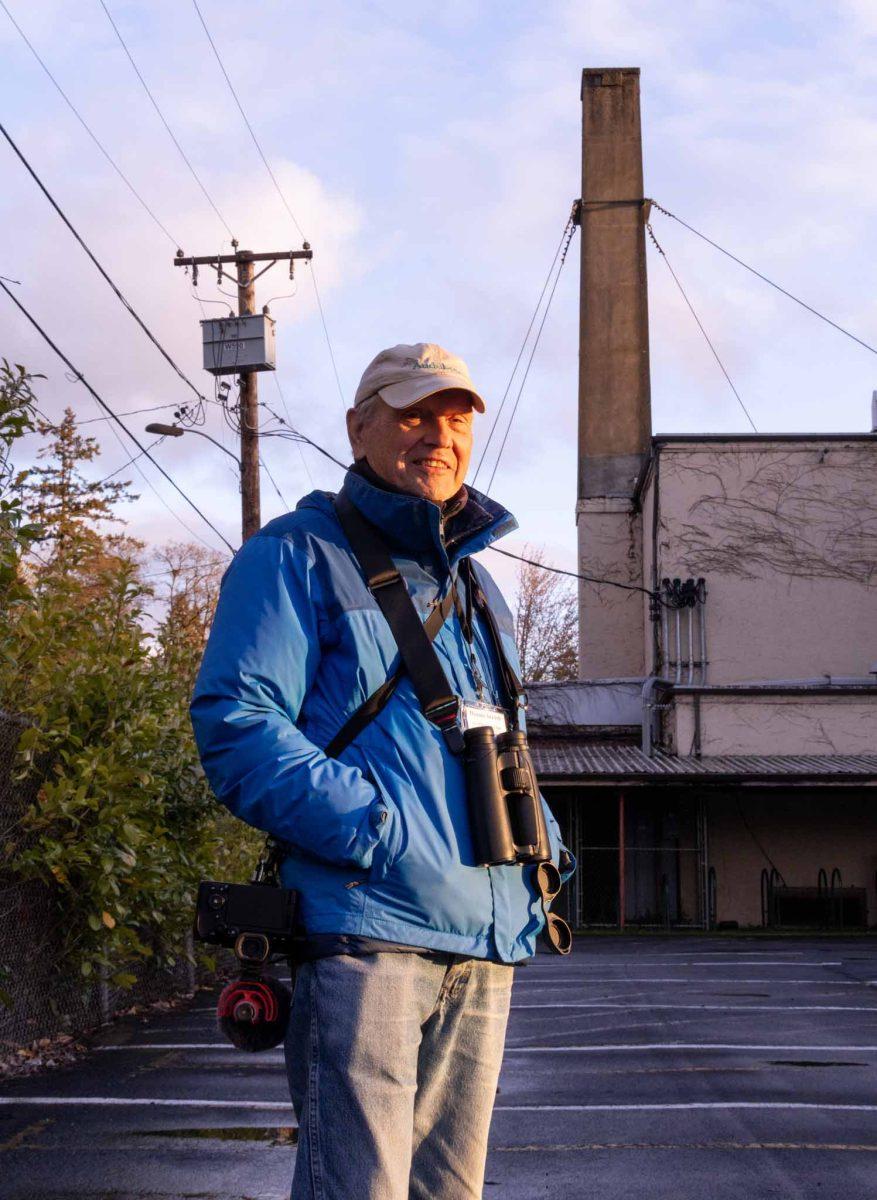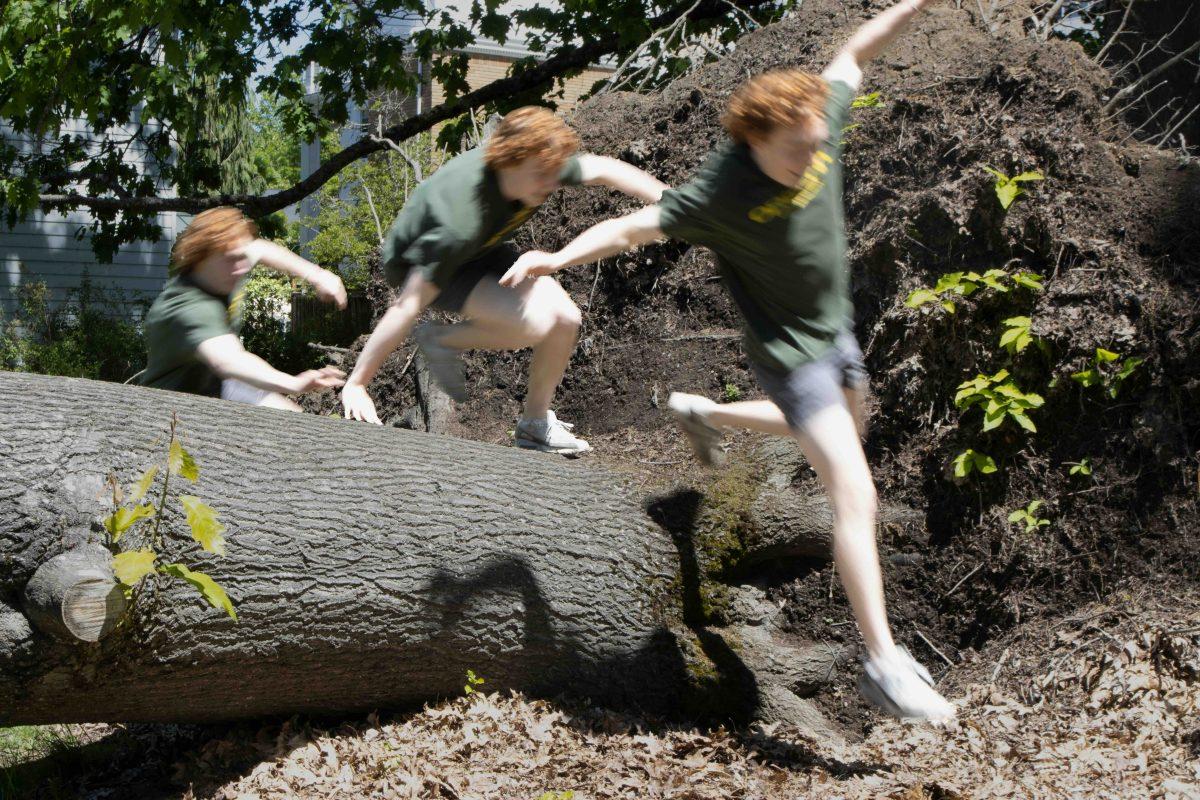If you’ve been cooped up at home and need to get out into nature, the Eugene Audubon Society will push you out of your nest and into the wild. They’ve been a fixture of the community for over 80 years, organizing different events each month as well as biweekly birdwalks. They’re the most welcoming and hawk-eyed bird watchers you’ll find for miles.
Just before sunset on the first Friday of April, eight birders gathered in a parking lot at the southwest corner of the UO campus to spend their evening staring at an old chimney. Two long-time members of the Lane County Audubon Society set up a table with a poster board providing information on the evening’s spectacle: the Spring migration of the Vaux Swift.
The informational handout described the bird as resembling a “cigar with wings” which is unable to perch on branches or telephones wires. They’re characterized by their unique tendency to make nests out of chimneys, which to them resemble hollowed tree trunks. Up to twelve thousand at a time twirl into chimneys along the west coast as they make their way from Mexico to the Pacific Northwest in the spring and as they return south with their offspring in the fall.
Dennis Arendt, program coordinator of the Eugene Audubon Society was among the 8 who turned out to the Agate hall parking lot. “I don’t feel calm as much as I feel focused on something that takes me away from my everyday worries,” he said. For the past 40 years he has found his escape by setting his focus skyward.
As the sun sank towards the horizon, a persistent silence in the air made clear to attendees that they would not be rewarded for their patience. For whatever reason, the Vaux Swifts would not be at their chimney roost that night.
Arendt was hoping to get a good view of their spectacular entrance to the chimney, but kept himself entertained when none showed up. The longtime birder isn’t abnormally patient and says he doesn’t like to spend too much time waiting to see a certain bird. Instead, he prefers to search for other birds which might be visiting his immediate surroundings.
When he does exert his patience to find a certain bird, he isn’t too irritated when he turns up short. “There is always disappointment when birding,” he said, “If it were always easy, it wouldn’t be as much fun when you do find the rare bird right where you expected it. It is heart pumping exciting to find a truly rare species.”
Though a parking lot in the middle of a college campus was far from his usual venue for a bird watching expedition, Arendt remained observant, keenly searching for other birds nearby.
Arendt estimated that about 100 birds lined the nearby fence of the track field. He proceeded to painstakingly pick out the few Brewer’s blackbirds from the mass of European starlings based on the length of their tails from the silhouettes he saw through his scope.
He attempted to log every bird in the area with an app called Ebird, a crowdsourcing app which helps birders and researchers keep track of populations and migratory patterns. It’s one of many free apps birders regularly use to track their bird sightings and identify bird calls. Arendt diligently tapped away, logging every fowl that flew overhead as he did on.
Arendt grew up in Chicago and began birding when, on a whim, he went on a trip with family to see a migration over the Mississippi River in southern Wisconsin. Like many dedicated birders, he tailors his vacations around crossing birds off his bucket list, and is never short on travel plans. “It takes you around the world, and often away from the touristy spots,” he said.
“Seeing an Ostrich running in the fields in Tanzania was mind-blowing,” Arendt said. Birds come in all shapes and sizes, and Arendt has fond memories with many different species. “Holding a hummingbird in your hand, seeing its tiny size and feeling its miniscule weight was something that everyone ought to experience once in their lives,” he continued.
The next morning was the monthly first Saturday birding. Turnout was double the prior month because the Audubon Society was able to gain special access to the Greenbelt Land Trusts newly acquired 1,500 acres of natural land just outside of Eugene. Amateur birders and seasoned Ornithologists of all ages bonded over their bucket list bird sightings and took pride in being the first to identify bird calls.
There has never been a better time to get into birding. Free apps enable anyone to track and identify birds wherever they are, and you’ll have plenty to log as Oregon ranks as the state with the 7th most bird species thanks in part to its coastal geography. “Many species are expanding their ranges,” said Arendt. The Willamette Valley is the perfect place to spread your wings, so check out the Lane County Audubon Society’s calendar and start your adventure today!






